Horror Under A Looking Glass: An Comprehensive Look at the Inclusivity of Candyman (1992 v. 2021)
There are few films as intricately crafted and widely known as that of Candyman, the story of the hook-wielding man whose backstory and myth revolve around his identity as a Black man. Though the 1992 film still remains popular now, with the release of the sequel Candyman (2021), an entire world of racial discourse has opened up surrounding both the fictional plots and the leadership diversity of the movies themselves. Now, the whispers of Candyman have turned into a full-blown discussion of the history of America and the power of stories to turn women into weapons and men into monsters.
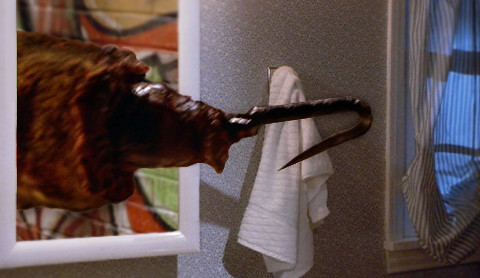
What Is the Inclusion Criteria?
The films were selected from RottenTomatoes Top 100 Horror Movies. Once selected, the diversity statistics of the films were analyzed, primarily in terms of the distribution of film leadership roles. The cast/crew roles included in the data analyses include director, writer, lead actors, producers, and executive producers. The data was also formatted into the racial categories of White, Black, Hispanic, Asian, and Middle Eastern, and the gender categories of Male and Female. This was all sorted into two separate pie charts for each movie.
How Can We Analyze Candyman (1992)?
Candyman (1992) drew a 77% rating from critics and a 62% rating from viewers on Rotten Tomatoes. Within its leadership, 14% of the cast/crew roles of the film were occupied by Black members, and 86% of roles were occupied by White members. In its gender diversity, 14% of the cast/crew is made up of female members, with a remaining 86% of male members.
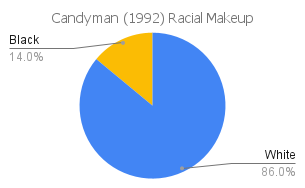
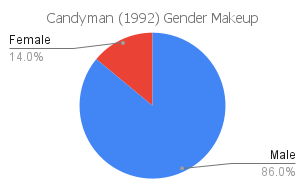
Though centered on racial violence and the horrors found within Black history, the original 1992 film is told through the perspective of graduate student Helen Lyle, a White woman who embarks on a research project surrounding myth and superstition. Through this, she finds out about Candyman, a hook-wielding Black man that appears before his victims after they say his name five times. After investigating the Cabrini-Green housing projects of Chicago, she comes face-to-face with both her skepticism and Candyman himself, who emerges from myth to terrorize Helen in the real world. She is blamed for his crimes but redeems herself by rescuing the baby of Anne-Marie McCoy, a resident of the housing projects, and seals her fate as a modern legend.
What Can We Take Away From the Films Interpretation?
With its detailed descriptions of Candyman’s past and present actions, the films message is expressed with clarity that comes to mind each time his name is spoken. Behind his role as the movie villain, Candyman’s character reflects the power of widely told stories, especially those told by the White society surrounding Black men. They are made into monsters, seen as a threat that has no name but is centered on sexuality; even in Candyman’s character, his use of his hook to slice his victims from the bowels up, and no mention of a past name mold him into this exact stereotype. This story gains further significance when White women are made into their victims, a tactic the White ruling class uses to justify violence against Black men, as occurred in Candyman’s tragic backstory. This also explains his present actions; by making Helen the scapegoat of his crimes, her role as a victim is removed, rendering her powerless in a still primarily White society.
What Is Helen’s Role Within The Film?
There are a few details amiss from the film’s racialized message, with the primary being Helen’s entire role in the story. Her perspective is told throughout the movie, one that does well to show prejudice and inequality as they are. This differs from her actual point of view as a White woman: her privilege is never acknowledged, except by herself as a means to elevate the righteousness of her character. This formation of her as a White savior delves even deeper into the plot, as when she saves the baby from Candyman, she becomes a myth respected and carried on by the Black community. The diversity present explains the plot detail within the film’s leadership; as mentioned above, with an 86% White cast/crew, there is little room for the truth surrounding America’s troubling racial past and present and White women’s role in it.
How Can We Analyze Candyman (2021)?
Candyman (2021) drew an 84% rating from critics and a 73% rating from viewers on Rotten Tomatoes. Within its leadership, 40% of the cast/crew roles of the film were occupied by Black members, and White members occupied 60% of roles . In its gender diversity, 30% of the cast/crew comprises female members, with a remaining 70% of male members.
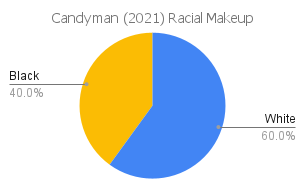
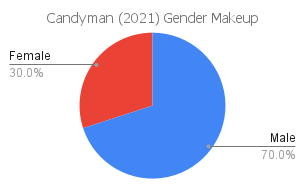
On the other hand is Candyman, the 2021 sequel that follows baby McCoy, now known as Anthony McCoy, and his connection to Candyman and the racial trauma that they share as Black men. He expresses these things through his artwork, which leads him down the path to recognition, both of the horrors of his past and who he is and becomes.
What Can We Conclude?
There is a vast difference in the new film, though, possibly explained by its leadership’s diversity statistics (mentioned above). There is no White point of view in the 2021 retelling of the legend, Anthony McCoy is the lead, not Helen Lyle or any other White character. The removal of the “need” for a White savior character opens up the idea that racial violence is a phenomenon that still exists in its past forms and carries on into the real world. There are no “good” or “bad” White people in this story, as these people have no individual impact on what occurs; there is simply violence against Black people, and not just to or by one single person. It is not an issue that can be resolved by one person either; cycles of trauma continue into the present day, affecting various individuals in so many different ways. But both versions of Candyman hold one thing in common: the country’s racial history is told through horror. Whether pieced as individual acts or cycles, these stories of violence are acknowledged for what they indeed are: the terror that runs through human lives, festering inside of them and eventually devouring them whole. While the cast/crew in the background of these films do influence how this history is told, the films remain some of the few that tell them and hopefully carry them on with their names.

